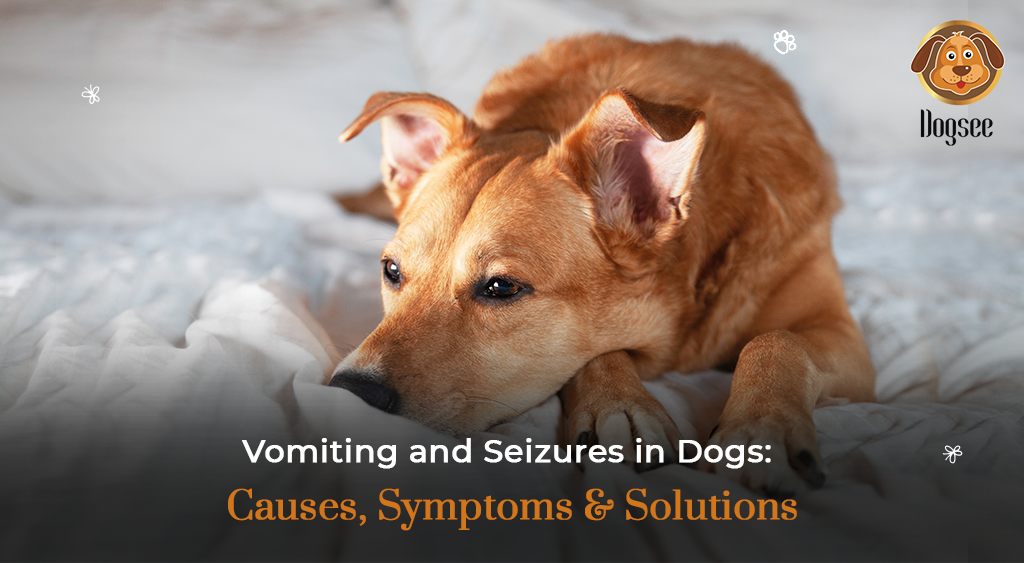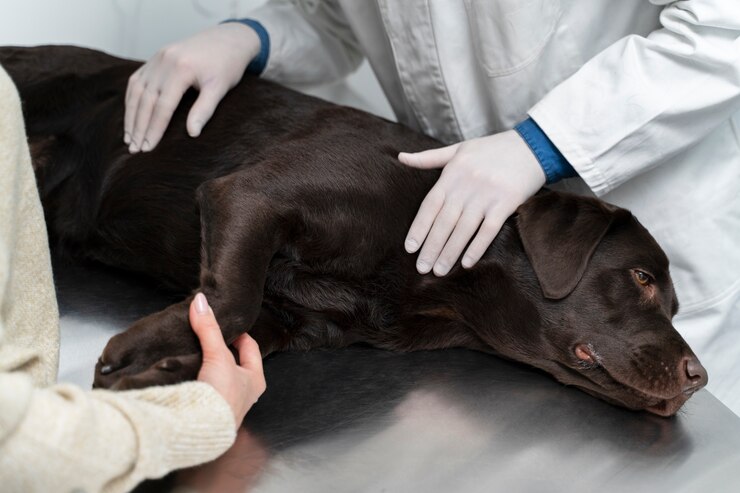
As responsible pet owners, we are committed to giving our dogs the best care and attention possible.
However, health problems can strike at any time, and two concerning issues that may cause you concern are vomiting and seizures in dogs.
Both of these symptoms can be upsetting for both dogs and their owners.
This in-depth guide aims to shed light on the causes, symptoms, and potential treatments for vomiting and seizures in dogs.
You can provide your furry friend with the necessary care and support if you understand these issues and how to respond to them.
Let's delve into the world of canine health and make your dog's health a top priority.
Part 1: Vomiting in Dogs

Understanding Vomiting:Vomiting in dogs is a common digestive issue. It's a natural reaction to get rid of harmful substances, but it can also be a sign of underlying health problems. Here's what you should know:
1.1 Causes of Vomiting:
Vomiting is a common occurrence in dogs and can be caused by a variety of factors, including:
Dietary Indiscretion: Dogs frequently explore their surroundings with their mouths, which can lead to them consuming items that aren't good for their stomachs, such as spoiled food, garbage, or toxic substances.
Food Allergies or Sensitivities: Dogs, like humans, can develop allergies or sensitivities to certain ingredients in their food, resulting in digestive problems.
Infections: Infections of the gastrointestinal tract, such as parvovirus and giardia, can cause vomiting as the body tries to expel harmful pathogens.
Obstructions: Vomiting can occur after ingesting foreign objects that become lodged in the digestive tract.
Pancreatitis: Pancreatic inflammation can cause digestive issues and vomiting.
Liver or Kidney Disease: Underlying organ dysfunction may cause gastrointestinal distress.
Poisoning: Ingesting toxic substances, including plants, chemicals, or certain human foods, can lead to vomiting.
1.2 Symptoms of Vomiting:
Recognizing the symptoms of vomiting in dogs is crucial for early intervention:
Repeated Vomiting: Vomiting on a regular or persistent basis is a clear sign of distress.
Lethargy: Vomiting often leaves dogs feeling weak and tired.
Dehydration: Dogs can quickly become dehydrated due to fluid loss from vomiting. Dehydration symptoms include dry gums, sunken eyes, and decreased urination.
Loss of Appetite: Dogs may lose interest in food, which can exacerbate dehydration and other health issues.
Blood in Vomit: Blood in vomit is a red flag that may indicate more serious underlying issues that require immediate attention.
1.3 When to See a Vet:
While some cases of vomiting can be managed at home, certain situations demand veterinary care:
Severe or Prolonged Vomiting: If your dog vomits persistently or if the vomiting is severe, contact your vet.
Blood in Vomit: The presence of blood in vomit is an urgent concern.
Other Concerning Symptoms: The presence of blood in vomit is a red flag that may indicate more serious underlying problems that require immediate attention.
1.4 At-Home Care for Vomiting:
Mild cases of vomiting can often be managed at home with the following steps:
Withhold Food: Withhold food for 12-24 hours to allow your dog's stomach to rest. However, to avoid dehydration, make sure your dog has access to water.
Reintroduce Food Gradually: When reintroducing food, offer a bland diet in small, frequent meals, such as boiled chicken and rice. Reintroduce your dog's regular diet gradually.
Monitor for Improvement: Keep an eye on your dog's health. Contact your veterinarian if the vomiting persists or worsens, or if other troubling symptoms emerge.
Part 2: Seizures in Dogs

Understanding Seizures:Seizures, also known as convulsions or fits, can be terrifying for both dogs and owners. They are distinguished by uncontrollable bursts of electrical activity in the brain. Here's what you need to know:
2.1 Causes of Seizures:
Seizures in dogs are sudden bursts of electrical activity in the brain. They can be caused by a variety of factors, and it is critical to understand the potential causes:
Epilepsy: Some dogs are genetically predisposed to epilepsy, which can result in recurrent seizures. This condition usually appears between the ages of six months and six years.
Brain Tumors: Tumors or abnormal growths in the brain can disrupt normal brain function and lead to seizures.
Toxins or Poisonings: Seizures can be caused by ingesting toxins or poisonous substances such as chemicals, plants, or certain human foods.
Head Injuries: Trauma to the head can result in seizures.
Infections Affecting the Brain: Certain infections, like canine distemper, may impact brain function and trigger seizures.
2.2 Symptoms of Seizures:
Seizures in dogs can vary in their presentation, but common symptoms include:
Muscle Twitching: Seizures often begin with muscle twitching, usually in the face or limbs.
Loss of Consciousness: Dogs experiencing seizures may lose consciousness or appear disoriented.
Uncontrollable Shaking: Seizures are often characterized by uncontrolled shaking or convulsions.
Drooling: Excessive drooling can accompany seizures.
Paddling Legs: Dogs may exhibit paddling movements with their legs during a seizure.
2.3 When to See a Vet:
It's important to know when a seizure warrants a visit to the vet:
Seizures Lasting Longer than Five Minutes: A seizure lasting more than five minutes is considered a medical emergency and necessitates immediate medical attention.
Cluster Seizures: If your dog has multiple seizures in a short period of time, this is a cause for concern.
First-Time Seizure: If your dog has never experienced a seizure before, consult your veterinarian.
Failure to Recover After a Seizure: If your dog doesn't fully recover within a reasonable time after a seizure, seek veterinary care.
2.4 At-Home Care for Seizures:
While at-home care cannot stop a seizure, you can ensure your dog's safety during and after a seizure by taking the following steps:
Create a Safe Environment: To avoid injury during a seizure, move objects and obstacles away from your dog.
Time the Seizure: Take note of when the seizure begins and ends. This information will be useful to your veterinarian.
Stay Calm: Stay calm and try to reassure your dog with soothing words and gentle petting during a seizure.
Rest After the Seizure: After a seizure, keep your dog in a quiet, dark room to rest and recover.
Part 3: Overlapping Symptoms
Vomiting and seizures can sometimes cause overlapping symptoms such as disorientation, confusion, and loss of consciousness.
In such cases, it is critical to seek immediate veterinary care because these symptoms may indicate a more serious underlying problem, such as toxin ingestion or neurological issues.
While all of this is important, pet parents should not overlook the importance of healthy and natural treats. As a result, in order to meet the dog's overall nutritional requirements Dogsee has a variety of products to meet all of your needs.
Part 4: Preventive Measures and Wellness
Proactive Health Care:
Regular vet check-ups can aid in the early detection and treatment of health issues.
To avoid certain infections, make sure your dog is up to date on vaccinations.
Nutrition:
Feed a high-quality, well-balanced diet that is tailored to your dog's specific requirements. Toxic foods such as chocolate, grapes, and onions should be avoided.
Safe Environment:
Protect your home from toxic substances by dog-proofing it.
Keep your dog out of potentially hazardous situations.
Stress Management:
Reduce your dog's stress and anxiety by socializing and training him.
Consider natural calming remedies or medication prescribed by a veterinarian.
Conclusion
Vomit and seizures in dogs are distressing issues that necessitate a proactive approach to health care. You can respond to these problems more effectively if you understand their causes, symptoms, and solutions.
While minor cases can be treated at home, more severe or persistent symptoms necessitate immediate veterinary care.
If you're looking for more dog-related blogs, like Vital Nutrients for Dogs and Their Sources you can check our blog section on the website.
Prioritizing your dog's overall well-being through regular check-ups, a healthy diet, and a safe environment can reduce the risk of these issues significantly.
Remember that your attentiveness and prompt action can make all the difference in your dog's health and happiness.
From interactive toys that provide mental stimulation to hard bars that are not only delicious but also excellent for dental health, we have it all. And for those special moments of bonding, our cookies and crunch treats are the perfect choice.
Don't forget to follow us on Instagram and Facebook so that you stay up-to-date about our latest products and promotions.
 HELPFUL0 people found it helpful
HELPFUL0 people found it helpful
Related Blogs
Subscribe to Our Blogs
and never miss on the latest update!


















